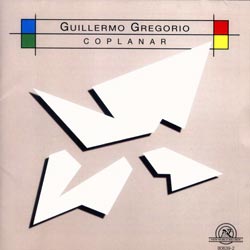|
|
 |
Dusted Reviews
Artist: Guillermo Gregorio Album: Coplanar Label: New World Review date: Jan. 30, 2006 |

|
|
|
 |
The always interesting reeds player and conceptualist Guillermo Gregorio has assembled a number of provocative ensembles over the years. Influenced early on by artists as seemingly disparate as Pee Wee Russell, Ornette Coleman, and Fluxus, Gregorio has usually explored his ideas in small group settings. It’s an exciting prospect, therefore, to check out his new Madi Ensemble, where his clarinet and alto sax are joined by Kyle Bruckmann (oboe and accordion), Jen Clare Paulson (viola), Fred Lonberg-Holm (cello), Michael Cameron (bass), John Corbett (guitar), Jim Baker (piano and ARP), Steffen Schleiermacher (piano), Marc Unternährer (tuba), Warren Po (cracklebox), Jennifer Walshe (vocals), Aram Shelton (clarinet), and Ken Vandermark (reeds). At first I was mildly disappointed to find that only one of the eight compositions – all interpretations of a larger graphic score – featured the whole ensemble, but the music is tasty enough that I got over it quickly.
The category “coplanar” is one of long-standing importance to the Argentine avant-garde that shaped Gregorio’s sensibilities. As best I can tell, it basically signifies the territory between the rigorous abstractions of post-Webern “classical” music and the earthier, direct music often heard in improvised settings. This certainly captures the feel of Gregorio’s music here, as on the opening “Coplanar 1 + 2” one can hear the intimate plucks of Corbett’s acoustic blending with reeds and synthesizers as the ensemble shifts and pinwheels continually. Movement is more important than settled sound environment; catalysis more integral than expression (though there are some moments of genuine wailing, not least Vandermark’s excellent bass clarinet on the concluding “Coplanar 5” and several wondrous statements from Bruckmann). Moving seamlessly between notation and improvisation, these pieces have a densely packed sound to them, almost as if they don’t want to be understood too readily. Quick slashes interrupt the concentration here, while unexpectedly rich drones emerge in the oddest places. Just when you think the music is about to tumble into klangfarbenmelodie, insectoid free improv scuttles derail things (as on the fulsome “Coplanar 4,” for oboe, clarinet, tuba, and cello). Several pieces feature a makeshift string quartet with soloists. And “White Coplanar” features the unpredictable cracklebox in a fascinatingly cranky textural essay.
The variety of textures, the wealth of detail, and the intensity of the musical interaction are all really captivating. Gregorio’s work is anything but easy, and it requires a good deal of patience and attention on the part of the listener. But it’s extremely rich and rewarding stuff.
By Jason Bivins
|







